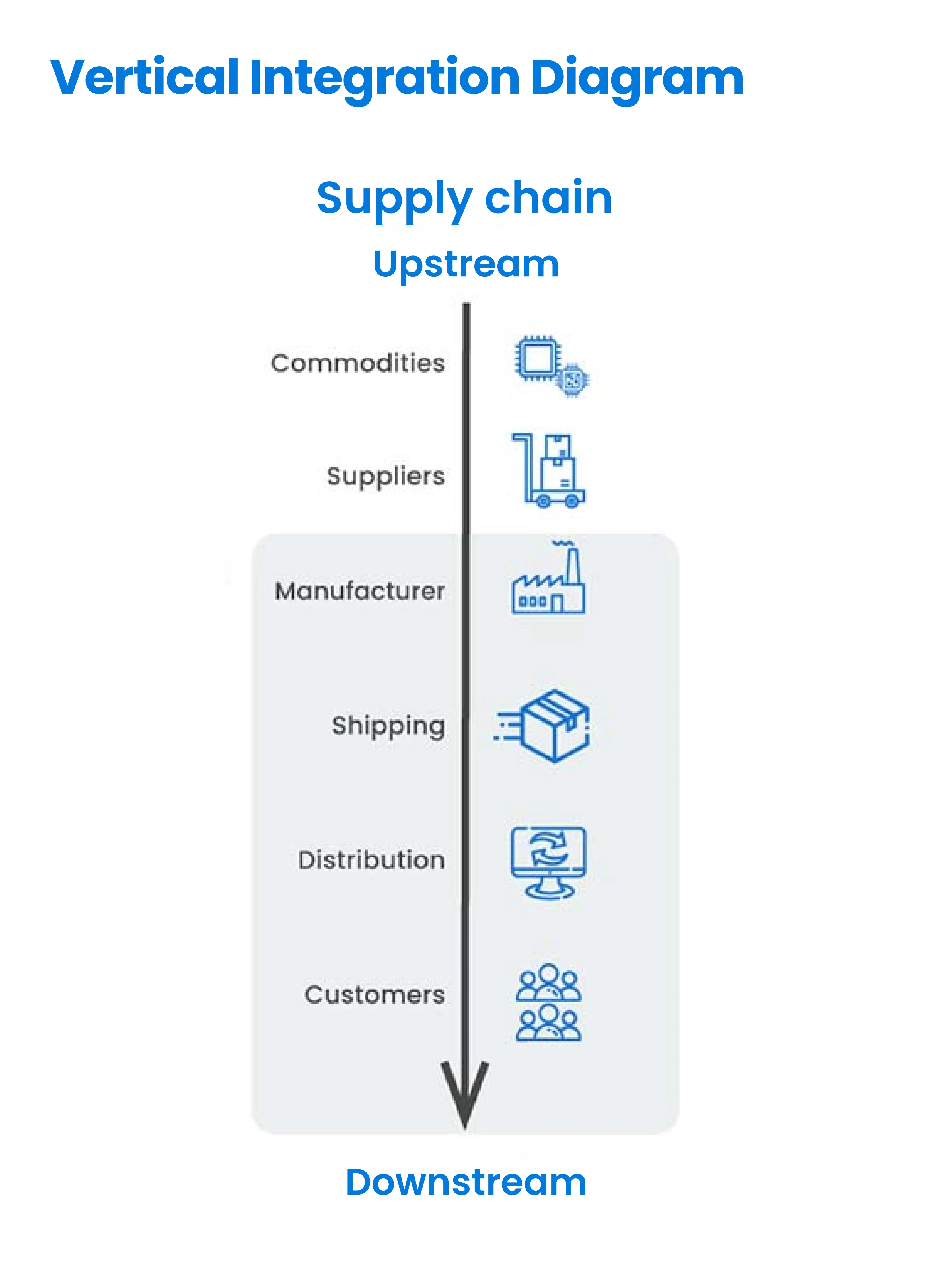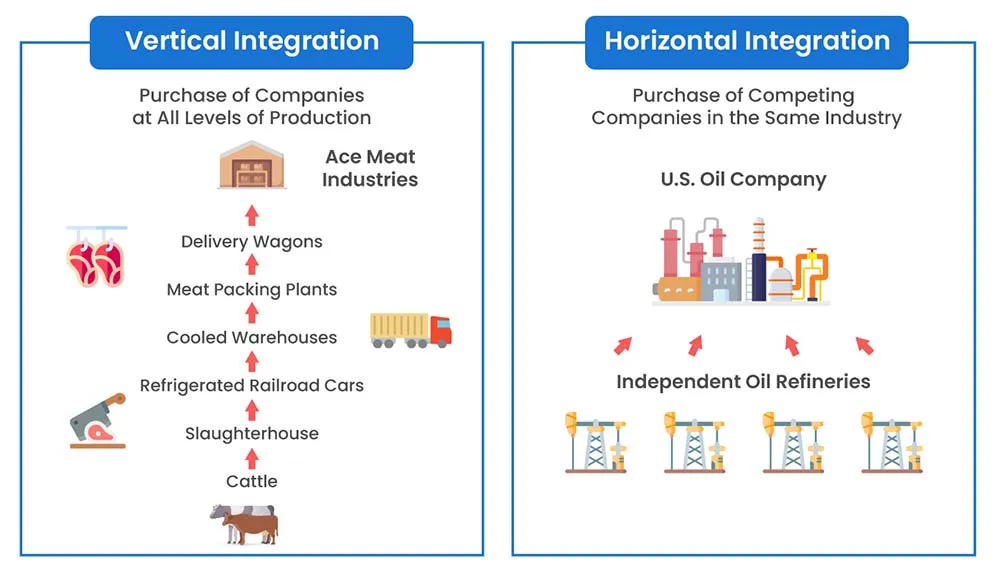Vertical Integration Explained: How it Works (+ Examples)


In the ever-changing landscape of the business world, M&A is often used as a tool to stay ahead of the curve and maintain competitive advantage. However, vertical integrations can be used to help companies streamline their operations and improve their supply chain management.
What is vertical integration?
Vertical integration is a strategy used by companies to achieve greater control over their supply chain, rather than relying on external suppliers.
This can be accomplished in two ways: acquiring companies that are part of their supply chain, or building their own capabilities to replace their existing suppliers.

How vertical integration works
Every business in the world has a supply chain - which includes every step from getting raw materials to order fulfillment (See image above). Vertical integration happens when a company decides to own and produce in-house one of the steps in its supply chain.
A perfect example of the vertical integration strategy is Apple. They design their own hardware and software, which allows them to control the entire production process and distribution process. This helps them maintain high standards of quality and innovation in their products.
Types of vertical integration
There are generally three types of vertical integration strategy (although the third is merely a mixture of the first two):
1. Forward integration
Do you remember the vertical integration diagram above? Forward integration simply means controlling the supply chain from where the company currently sits, all the way towards the customers. The goal is to increase control over how their products are being sold.
Netflix is a perfect example of a company that utilized a forward integration strategy. As we all know, Netflix is a streaming video service company that allows customers to watch tv shows and movies over the internet, by compiling a wide variety of content into their platform.
But by employing a forward integration strategy, Netflix has begun producing their own original content. This strategy has allowed them to gain control over its library and reduce their reliance on external content providers whose licensing fees are becoming more expensive.
2. Backward integration
Backward integration is the complete opposite of forward integration. This time, the company aims to control their supply chain towards the supplier, or commonly referred to as upstream. The goal of this strategy is to secure a more reliable supply of materials, reduce production costs and improve efficiencies.
One example of backward integration strategy is when the Swedish furniture company IKEA decided to buy forests in Romania and the Baltic states to gain control over its raw materials. This will prevent unexpected disruptions in their supply chain, while enjoying lower costs.
3. Balanced integration
The balanced integration strategy is simply the combination of both forward and backward integration strategy to create a more ‘balanced’ vertically integrated company.
Degrees of vertical integration
The degree of vertical integration measures how much the company controls their supply chain. Here are the primary degrees of vertical integration:
1. Full vertical integration
The company is considered fully vertically integrated when it controls all aspects of its production from raw materials to final sales. This is the most comprehensive form of vertical integration.
2. Quasi vertical integration
In this state, the company does not own all, but has significant control over its supply chain. This control may be through exclusive agreements, specialized investments or substantial stakes in the partner companies. In short, the company has minority ownership, but not full ownership.
3. Long-term contracts
The company completely relies on long-term contracts with its suppliers and distributors to secure a stable supply chain and sales outlets without the risks and investments associated with higher degrees of integration.
4. Tapered vertical integration
This degree of vertical integration involved a company mixing in-house production and purchasing externally. On the other side of the spectrum, they also sell some of its products directly to consumers and some thorough independent entities.
Vertical vs. Horizontal integration
Before we go any further, let’s differentiate vertical integration and horizontal integration.
While vertical integration means gaining more control of different stages in the supply chain, horizontal integration is a business strategy where the company buys its direct competitors, who produce the same type of product, at the same level in the industry.
The goal of horizontal integration is to increase market share and enjoy economies of scale while reducing competition.

Advantages and disadvantages of vertical integration
Advantages
- Control over costs - Vertical integration allows companies to reduce, or atleast, control costs associated with their suppliers, producers, and distributors. This will eliminate unnecessary and unexpected increases in costs.
- Control over supplies - By controlling more stages in the supply chain, companies can ensure efficient inventory management. If it’s backward integration, the company can increase or decrease production anytime they want. If it’s forward integration, the company can streamline their logistics and delivery schedules.
- Economies of scale - Increased operations will result in economies of scale. This will instantly reduce cost of raw materials and improve profit margins of the company.
- Create new income streams - Buying another operating business or creating new capabilities will definitely create a new cash flow. For instance, a manufacturing company opening their own retail stores.
- Maintain quality control - Just like the previously stated example, Apple controls their hardware and software. This allows them to maintain quality control in all of their products.
- Create barriers to entry for competitors - A vertically integrated company may have the capability to restrict competitors access to certain raw materials or resources. This will result in increased market power. Think of a car manufacturer who just bought a tire manufacturing company. That company can now refuse to sell its tires to other competitors.
Disadvantages
Despite the amazing benefits of vertical integration, it’s not perfect. Here are the drawbacks of vertical integration.
- High capital requirements - Acquiring or establishing a new operation at different stages of the supply chain requires significant upfront capital. This can include purchasing a company, setting up new facilities or investing in equipment.
- Reduced Flexibility - Because of the high capital requirements, a vertically integrated company will have a hard time adapting to changes in the market, or even exiting the business.
- Risk of Distraction from Core Business - Expanding operations and managing multiple aspects of a supply chain can distract the business from their core competencies, leading to inefficiencies.
- Potential for Inefficiencies - Speaking of inefficiencies, if the company owns multiple stages of its supply chain, and is inefficient in running one of those operations, the entire chain can suffer.
- Regulatory and Legal Risks: Higher degrees of vertical integration can also attract scrutiny from regulatory authorities, particularly in terms of antitrust issues. This can lead to legal challenges and restrictions, impacting the business operations and its competitive landscape.
Is vertical integration profitable?
In a nutshell, YES! Just like any other M&A transaction, it can be extremely transformative and beneficial to the acquiring company if done right. With the good strategy in place, coupled with the right target company and an efficient M&A integration, vertical integration can be profitable.
Just think about it. If the company owns anything upstream, they can reduce, or control their costs, while maintaining good quality raw materials. If the company is vertically integrated downstream, then they have better control over their pricing, and remove unnecessary costs.
Examples of vertical integration
Here are some of the most notable examples of vertical integration.
Backward integration: The Ford Motor Company at River Rouge, MI
Over 100 years ago, Ford Motor implemented the first moving assembly line. Using the vertical integration strategy, they controlled every stage of production, from raw materials to sales. They bought 2,000-acre of land in the River Rouge, and built a plant there to gain access to a steady supply of raw materials. To complete the vertical integration strategy, Ford also purchased a railroad, 16 coal mines, built a sawmill, and even bought a glassworks.
The company acquired every single component needed to manufacture a car. A sales operation was also in place to ensure complete vertical integration.
Forward integration: Amazon’s acquisition of Whole Foods
In 2017, Amazon aimed to expand its presence in grocery purchases in the United States. However, grocery purchasing was historically considered challenging for e-commerce due to its requirement for freshness and lack of physical retail presence. This is one of the major reasons Amazon decided to acquire Whole Foods for $13.7 billion. Soon after the deal closed, Amazon began integrating its technology into retail stores.
Five years on, the company is now rolling out a series of Amazon Fresh stores across the U.S. These smaller convenience stores represent another vertical integration move by Amazon, focusing on acquiring assets (i.e. the properties) instead of acquiring another company.
Balanced integration: Facebook(now Meta)
Facebook is one of the companies that exemplifies a balanced integration strategy (i.e. backward and forward integrations). In the last decade and a half, Facebook’s notable forward integrations include acquiring Instagram for $1 billion in 2012, and WhatsApp for $19 billion in 2015. These are the customer-facing acquisitions and upstream buys.
Additionally, Facebook has made nearly 100 acquisitions over this period, often in back-end software that underpins the customer-facing apps (i.e. backward integrations).
This balanced integration strategy effectively improves the supply chain (in Facebook’s case, Intellectual property, technology, and technology talent) to power the front end (in Facebook’s case, customer-facing platforms like Instagram, the videos that play on Facebook’s own platform, and WhatsApp messenger - the world’s most popular mobile communications tool).
Get your M&A process in order. Use DealRoom as a single source of truth and align your team.



.webp)






.png)
.png)
.png)
.svg)

.svg)
.png)


